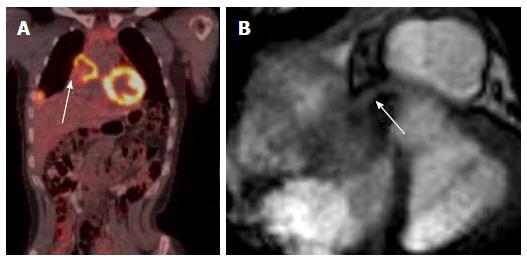Copyright
©The Author(s) 2017.
World J Cardiol. Jul 26, 2017; 9(7): 600-608
Published online Jul 26, 2017. doi: 10.4330/wjc.v9.i7.600
Published online Jul 26, 2017. doi: 10.4330/wjc.v9.i7.600
Figure 1 Localization of abnormal fluorodeoxygluocse activity in the heart.
A: Axial fused PET-CT image shows focal intense FDG uptake in the heart (arrow) in patient with melanoma that thought represents cardiac metastases; B: Selected delayed enhancement short axis image of the same patient with other images (not shown) shows no abnormal enhancement or tissue infiltration, the FDG uptake was corresponding to hypertrophic papillary muscle, follow PET-CT was normal. PET: Positron emission tomography; CT: Computed tomography; FDG: Fluorodeoxygluocse.
Figure 2 Localization and characterization of abnormal fluorodeoxygluocse activity in the heart.
A: Axial PET-CT images in patient with history of invasive thymoma underwent surgical resection shows intense FDG focal uptake in the cardiac apex highly suspicious for cardiac metastases, review CT component of PET-CT shows area of and soft tissue; B: Four-chamber DE image with triple inversion recovery shows complete fat suppression of the apical activity in keeping with brown fat (arrow), with high signal fluid intensity consistent with post-operative lobulated fluid collection (arrowhead). PET: Positron emission tomography; CT: Computed tomography; FDG: Fluorodeoxygluocse.
Figure 3 Localization and characterization of abnormal fluorodeoxygluocse activity adjacent to the heart.
A: Localization and characterization of abnormal FDG activity adjacent to the heart. Axial PET-CT image of the heart shows a non-FDG avid nodule near the base of the heart (arrow), PET-CT was performed for incidentally discovered nodule mass on Echocardiography. The study was otherwise unremarkable; B: Axial first pass perfusion image shows highly vascular intrapericardial tumors with no evidence of tissue invasion (arrow); this lesion was surgically removed and pathologically proven schwannoma. PET: Positron emission tomography; CT: Computed tomography; FDG: Fluorodeoxygluocse.
Figure 4 Localization and characterization of abnormal fluorodeoxygluocse activity adjacent to the heart.
A: Axial Ga-68 DOTATATE PET/CT shows a focal intense radiotracer uptake adjacent to the heart with difficulty to accurately localize; patient is known to have history of ileocecal area carcinoid and underwent surgery; B: Coronal first pass perfusion images show highly vascular lesion in the tip of the left lobe of the liver corresponding to abnormal radiotracer uptake, this location is very common for PET-CT misregistration and there was no focal lesion identified in CT component of PET-CT. PET: Positron emission tomography; CT: Computed tomography; FDG: Fluorodeoxygluocse.
Figure 5 Differnation between tumoral thrombus from bland thrombus.
A: Differnation between tumoral thrombus from bland thrombus in patient with history of thyroid cancer treated with total thyroidectomy presented with neck mass. Coronal fused FDG-PET image shows intense linear FDG uptake from in the thyroid bed (white arrow) and spreading through SCV to the right atrium (red arrow); B: Four chamber cine image shows irregularly defined mass in the right atrium (arrow), the rest of cardiac examination was unremarkable; C: Axial HASTE at the junction of superior vena cava and right atrium shows a high signal intensity mass (arrow). PET: Positron emission tomography; CT: Computed tomography; FDG: Fluorodeoxygluocse.
Figure 6 Differnation between tumoral thrombus from bland thrombus.
A: Differnation between tumoral thrombus from bland thrombus in female patient with history ovarian cancer, patient was known to have chronic pulmonary embolism, there was a bland thrombus almost occulting the left pulmonary artery was no FDG uptake (arrow); B: Axial CT image shows a left pulmonary artery thrombus. CT: Computed tomography; FDG: Fluorodeoxygluocse.
Figure 7 M staging.
A: M staging: Coronal PET-CT image of patient with lymphoma with unexpected cardiac involvement; B: Axial T1-weighted image at the level of interatrial septum shows well defined mass attached to the atrial septum and nearly fills the right atrium and was proved to be lymphoma. PET: Positron emission tomography; CT: Computed tomography.
Figure 8 Evaluation of the aggressiveness of the lesion and assessment of cardiac involvement.
A: Evaluation of the aggressiveness of the lesion and assessment of cardiac involvement; whole body PET-CT image of patient with extensive Ewing sarcoma of the left hemithorax, PET-CT images are not sufficient to evaluate local extension of the tumor to the heart; B: Axial delayed enhancement image shows large necrotic mass occupying the left hemithorax with direct left ventricle (upper arrow) the arrow without circle and left atrial invasion (lower arrow). PET: Positron emission tomography; CT: Computed tomography.
Figure 9 Evaluation of the aggressiveness of the lesion and assessment of cardiac involvement.
A: Evaluation of the aggressiveness of the lesion and assessment of cardiac involvement; Coronal PET-CT image in a patent with Ewing sarcoma of the left chest wall with direct compression of the left side of the heart; B: Coronal Post contrast T1-weighted image of the heart shows no evidence of cardiac invasion with clear separation of the mass from the heart, the mass was surgically removed and there was no evidence of cardiac invasion. PET: Positron emission tomography; CT: Computed tomography.
Figure 10 Evaluation of coronary artery involvement by the tumor.
A: Coronal PET-CT image in a female patient with history of breast cancer with mediastinal and lung metastasis and recurrent chest pain; B: Axial cine image at the base of the heart shows metastatic lesion invading the heart causing mechanical obstruction of the right coronary artery (arrow). PET: Positron emission tomography; CT: Computed tomography.
- Citation: Fathala A, Abouzied M, AlSugair AA. Cardiac and pericardial tumors: A potential application of positron emission tomography-magnetic resonance imaging. World J Cardiol 2017; 9(7): 600-608
- URL: https://www.wjgnet.com/1949-8462/full/v9/i7/600.htm
- DOI: https://dx.doi.org/10.4330/wjc.v9.i7.600


















